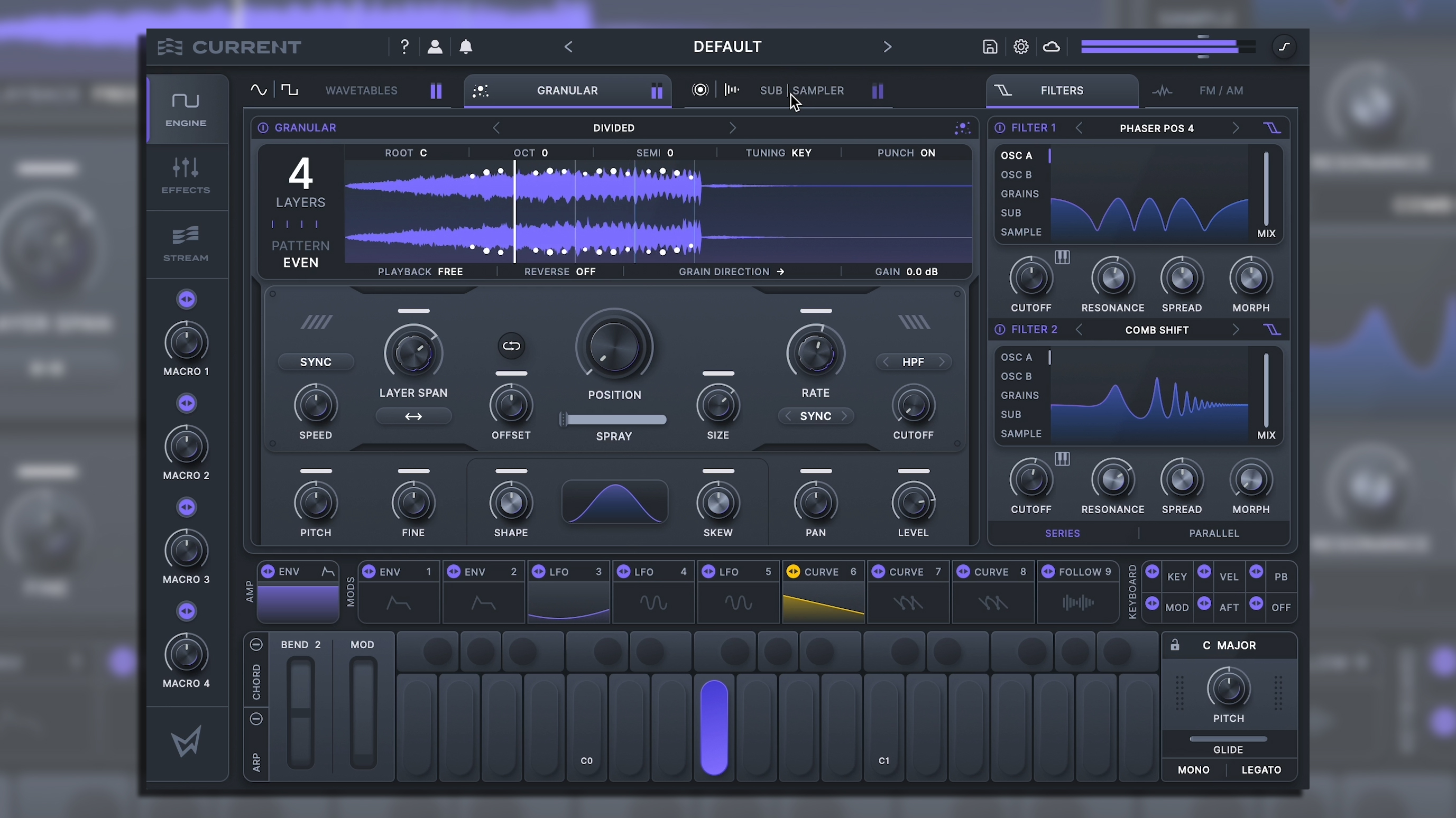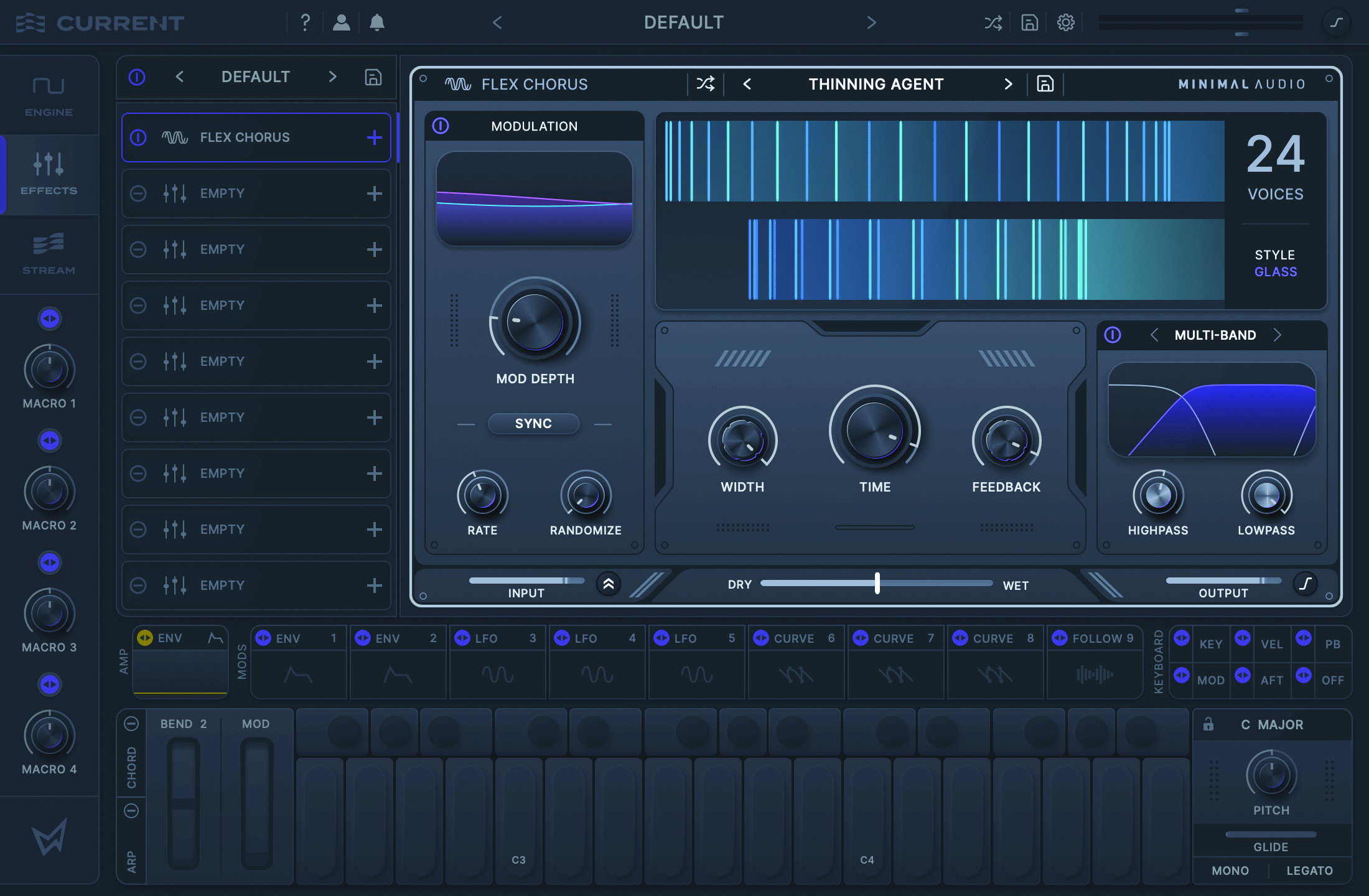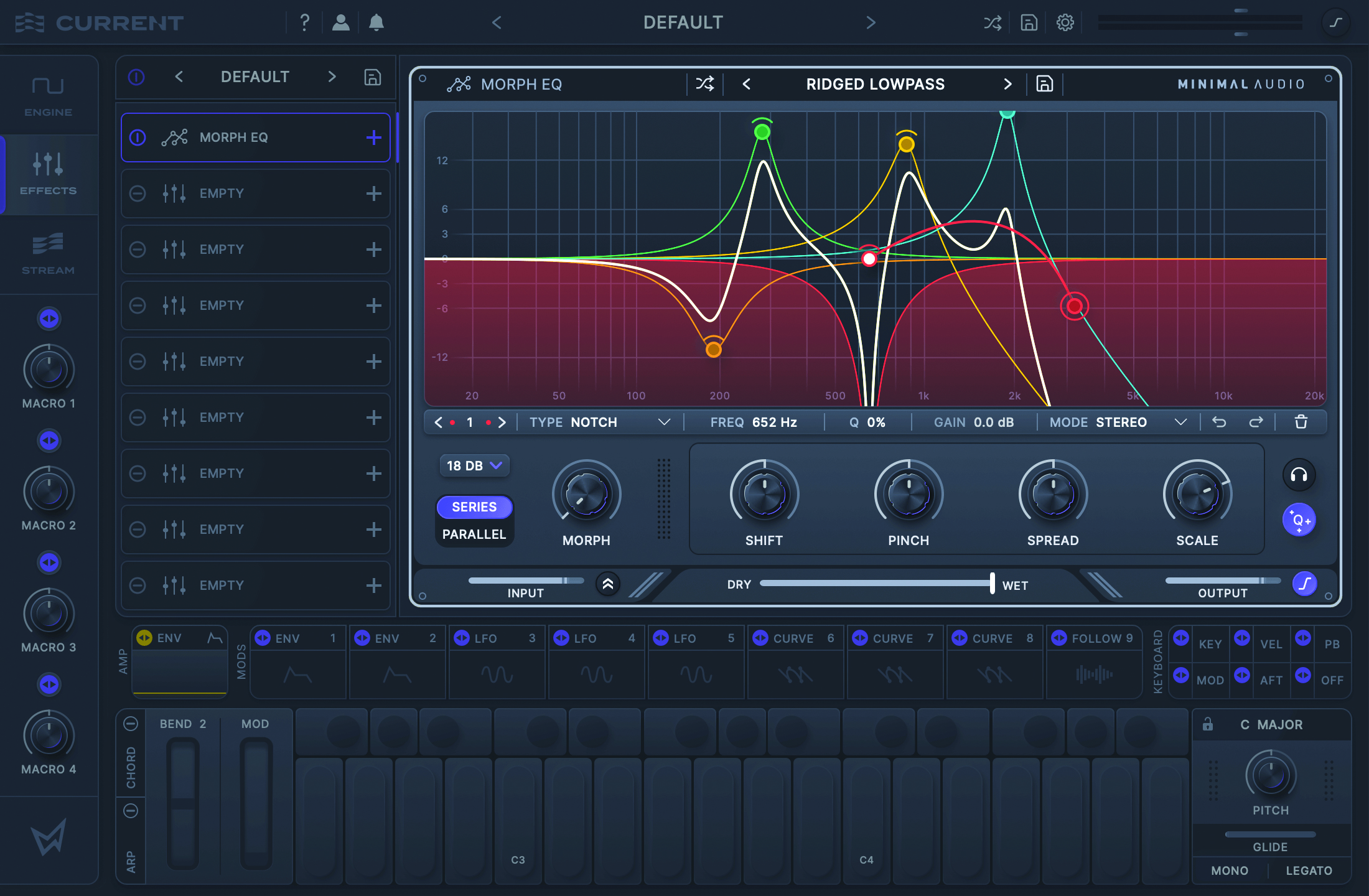Minimal Audio: "One of the best things about the music technology industry is that it’s one of the only places left where indie people can make something special that means something"
We sit down with Jacob Penn, Ben Wyss and Nathan Wexler of Minimal Audio to hear more about the development of their latest soft synth and content platform, Current

With 5 powerful sound engines, a huge array of modulation options, FM synthesis, and more, Current is a sound designer's dream soft synth.
View at Plugin Boutique
Following industry-wide acclaim for its roster of top quality effects plugins, Minimal Audio finally brought a delicious synth to the table in 2023.
But what makes Current so different to the other synth plugin offerings out there? We caught up with the company’s head honchos to dig in a little deeper…
Can you give us an overview of how Current differs and expands on what you’d typically expect from a software synth?
Jacob (Jake): “We’ve all been using synths since we were kids. Typically you look at synths and they make sounds right? That’s been pretty normal since the inception of them, but things are changing and there’s more capability. There’s more processing power and there’s also just kind of a vision we have for the product and for the company that was there from the outset.
“The idea was to build an ecosystem around a single product. We knew from the start that we wanted to make a synth with effects built into it, but we didn’t want to have normal stock effects with three knobs that you can’t really dial in your sounds with. We find that it makes it really hard to make a final patch in the synth when things are constrained to that level. So we knew we wanted to build a collection of plugins that all formulate into one larger parent plugin.
“So when you open up Current you’ll see that all of our plugins are inside it, and all of the plugins originated from inside Current and were taken out to be released separately. We’ve been building Current since the beginning but we haven’t wanted to reveal that. We’re self-funded and we’re boot-strapped, so we particularly like the idea of the ecosystem concept, because it makes a really nice workflow going from product-to-product.
“It’s been a mix of ‘what can we do technically?’ and ‘what can we do to make a really kick-ass product as well as fulfil our vision of making a very, very good synthesiser?’. The basis for that vision for it made us approach the design of it differently to how others have probably designed their synths.
Want all the hottest music and gear news, reviews, deals, features and more, direct to your inbox? Sign up here.

“The other part of it is that we want to continue to develop the synth for the rest of our careers. We really want this to be the product that we just get to make better and better every year. How do we keep stuff fresh? Well you might download a softsynth but if you don’t use them for a while, you might rinse the presets and then they fall by the wayside.
“We wanted to add the cloud connectivity aspect that’s widespread right now. But samples aren’t everything. If you had a preset that created sample-quality sounds in the synth itself, then distributing presets is a lot more intriguing than distributing individual sounds. If you’ve listened to our Current presets, they sound more like loops.
“And, we’ve designed them so they’re supposed to be played as instruments, but if you hold the note down longer it’ll give you a musical idea. A lot of patches will start with the stab and you can use that stab to play an instrument, but if you hold it down, a tail end of the sound will come out and give you more interesting musical ideas.
That level of layering is really what makes modern-sounding, lush, full spectrum electronic music sounds
“The way that we do sound design in the company is based on using instrument racks. These are very different to synthesisers – it’s difficult to dial them all in together because you’re flipping between opening so many different plugin UIs. Say you want to change the attack slope on your sound, but your sound is made up of five different layers on five different synth patches. Now you’re opening up five different synths to edit five different ADSRs.
“That level of layering is really what makes modern-sounding, lush, full spectrum electronic music sounds. Getting the capability to do that in one product grants you presets that sound like samples. That’s the vision. We want to make a synth that is so powerful that you can make sounds right inside of it; [one that] offers anything you could want out of sound design.
“It doesn’t sound very ‘minimal’ to have a synth that does all that stuff. Once you learn it and get into the flow with it, there’s really nothing more minimal than having your DAW and one synth on a DAW channel and removing that entire strip of effects – and all that jumping around between different plugins and different products.”
So it sounds like building towards Current was always on the cards? How long has it been in development?
Ben: “There’s not like a super clear answer to that question, but for over two years we’ve been working on this plugin as our main project. It goes back a lot further. We were working on Rift before that (which is tied in to this via its DSP). Then it goes back even further with the stuff that Jake and I talked about before Minimal Audio. I guess to the design decisions and building things with stuff like Macro knobs.”
Jake: “It goes back a really long way for me – I wanted to build this synth before I learned how to code. If we think about when it started, it really was my catalyst to begin learning how to be an engineer.”
Ben: “Especially the granular sampler in there, I remember talking to Jake about that five years ago. Since we first launched, it’s really been the focus completely. We’ve had to release other things before this, but really it’s all been kind of focused around this release. Everything that we’ve ever made is now in Current.”
Jake: “The Minimal Audio team is all new, young people. We don’t have any industry veterans working for us. Rift was also a big education for the company – it was essentially ‘here’s how you build a normal plugin’. Once we had that unlocked, then we were ready to build something this complicated. You really can’t build something like Current as your first project in your career, it’s too complicated.
We’re very proud of our wavetable oscillators; they use spectral processing which allows for perfect anti-aliasing, which is really nice, and also for us to do some really cool effects
“The plugins were developed ‘inside’ of Current before Current was a thing. We’ve had an ugly version of it for a long time. We needed to have a design system that supported breaking the effects out standalone. I guess there are more ideas for more Minimal Audio effects that will come out of this. We had to cut half the effects from this, but there’s a lot more effects and we’re planning to release another effect every quarter – that’s something that will be added to Current. We’ll be slipping it in one day.”
The wavetable oscillators look deliciously fun to get creative with. How flexible is this area and can you incorporate your own wavetables?
Ben: “We’re very proud of our wavetable oscillators; they use spectral processing which allows for perfect anti-aliasing, which is really nice, and also for us to do some really cool effects. There’s the position knob in the middle which is the classic ‘change wavetable position’ control, then to the right of that there are two controls called ‘Wave’ and ‘Warp’; they’re both effects that come one after another. These include more classic effects like flanging and wavefolding, as well as synth effects like sync and hard sync. Then the spectral side of things is the other effect, that includes things that I haven’t seen anything else really do.
“There’s a formant shifter that’s really great that you might expect to see in a vocal suite, then there’s spectral filtering effects like unique phasers that remind me a lot of additive synths. Something that you might see in Razor.”
Jake: “There’s additive distortion too. We can control the frequency and make sure that no aliasing comes into play from the distortion being applied.”
Ben: “You can get those effects to interact in really interesting ways, especially if you do modulation. I think of it like three-dimensional wavetables – adding more to the initial two dimensions. Of course, there’s Unison which sounds great, and yes, you can import your own wavetables. We imported an algorithm which enables you to drag and drop; it’ll slice it and process it. We’d like to go further and eventually develop a full wavetable editor.”
Jake: “There are a couple of different modes for importing, but you can drop whatever in there and it’ll detect the pitch and make wavetables out of it. Most of the time it’ll sound pretty cool. If you have existing wavetables it’ll import them perfectly.”

How can the sub oscillator be used?
Jake: “That’s a good question and it pairs with the wavetable section quite well. An additive sub-oscillator is something I’ve been meaning to build for a long time. If you think about Reese basses, they’re typically made by de-tuning two square waves or saw waves against each other to create that kind of Reese movement.
“But the issue with that is that you get the nice phasing sound that you really only want in the mids and the highs, but your sub does the ducking also. The bass becomes unstable and you get these volume dips in the fundamental of the sub frequencies. What an additive sub-oscillator allows you to do is to modulate and apply those de-tunings to just the upper harmonics of the sound.
“You can have a rock solid sub-fundamental with lots of interesting, characteristic high stuff going on. In the synth environment it pairs really well with the wavetables because you have the option to FM/AM everything but also you have a button on the wavetable called ‘remove fundamental’ – if you want to replace the sub with the sub oscillator, it’s a one-click and you can replace it with the perfectly stable sub-oscillator with that interesting harmonic control. So you could use the wavetable function for your mids and your high ends and then the sub oscillator for your lows.”
How will Current continue to expand over time? Will there be more presets and packs produced for it?
Jake: “We’re not happy with the presets that come with synths, I can say that confidently. We believe that the presets we’ve made for Current will actually inspire people and show them what it’s capable of. I think Nate’s done a fantastic job on this.”
Nathan (Nate): “Yes, we worked with artists around the world to create the presets and kind of the philosophy behind the presets was to create ‘song starters’. I view Current as the ultimate layering tool. With the integration of the core module you can really layer things and get song ideas out right away.”
Jake: “We plan to release content at the very least monthly.”
Nate: “We’re working with around 30 sound designers around the world. We would like to have weekly content with new presets, new wavetables, new samples etc. It’s always going to be growing. Providing people with more inspiration to work with.”
Jake: “Even if Current was just a preset player, and didn’t have all the surrounding depth and complexity, it’d still be worth it due to the quality of those sounds. We’re confident that if people give it a shot, they’ll stick with it. You can really play them too. Working with samples can be quite limiting, but with this you can re-pitch and perform with them on the fly.”
Nate: “Maybe at some point we’ll be adding a few more ‘simple’ presets, but we wanted to really explore the layering component with these first iterations of presets. Based on feedback we’ve got so far, we’ll sort of shift our vision, but this is what we wanted to do out of the gate.”

Which of Current’s features are your favourites to use?
Nate: “For me, working with it so much, I love being able to mix the digital and organic components of the sounds. I love working with the sub and the wavetables, mixed with the granular to create these expansive composites of sounds. I also love that you can play vocal chops inside the synthesiser. You can manipulate those with oscillators. I also love the Chord Generator. I’m not a big music theory guy myself so being able to use the Chord Generator inspires a lot of music ideas for me.”
Ben: “One of my favourite ideas is the granular sampler, and there’s something we came up with that we’re calling ‘layers’, which is basically adding more grains. If you have four layers that start to overlap and you can actually start to sequence them in different ways, in time and in playhead positions, you can do these things that are extreme. It’s almost like nonlinear loop sequencing. Part of the reason I love the granular sampler so much is a combination of everything the three of us have worked on. It comes together in a really cool way. You can just do some things that I don’t think other things can do. Interesting approaches to playing back samples.”
Jake: “For me it’s just the overall user experience. The Stream is built in a way where it’s not meant to replace the traditional synth experience. I think we’ve found a nice balance between exploration mode and writing mode. It doesn’t feel like the two things are competing. There are separations of concern inside the instrument that allow you to focus on distinct areas.
We didn’t want this synth to feel like it had to be ‘on the internet’ to work. What good is a synthesiser if you can only use it when you’re online?
“We didn’t want this synth to feel like it had to be ‘on the internet’ to work. What good is a synthesiser if you can only use it when you’re online? There’s a strong focus on local mode and a strong focus on getting what you want, downloading what you need – grab what you want and head back to making music. We don’t want you to spend all day getting distracted.”
Ben: “Something else that we can add to that is that you can make your own preset packs. You can customise kind of like the experience for yourself. You can favourite things so they’ll show up immediately in the engine view. If you want to load one of your regular samples they’ll be there waiting at the top. I hope people are able to make it their own. We want to continue to provide that but we did a lot of stuff upfront to make it customisable. We want people to stay focused on stuff.”
What does the future hold for Minimal Audio, and how do you reflect on the company’s successes so far?
Jake: “Nate and I have been friends since we were 14 – and Ben and I since we were 18. We all basically learned music together. One of the best things about the music technology industry, and plugins in general, is that it’s one of the only places left where indie people can make something special and means something, and can go to market and make a business for themselves. You wouldn’t see these three dudes teaming up to make a healthcare company, you know what I mean? The accessibility we have to actually make something cool is unmatched.
“We love the other developers making their great products too and we hope everybody has a ton of success and makes awesome tools. I want to put that note out there. This industry is one of the few places where we can build what we want without having to sell our souls.”
Find out more about Current over at Minimal Audio's website.



I'm Andy, the Music-Making Ed here at MusicRadar. My work explores both the inner-workings of how music is made, and frequently digs into the history and development of popular music.
Previously the editor of Computer Music, my career has included editing MusicTech magazine and website and writing about music-making and listening for titles such as NME, Classic Pop, Audio Media International, Guitar.com and Uncut.
When I'm not writing about music, I'm making it. I release tracks under the name ALP.